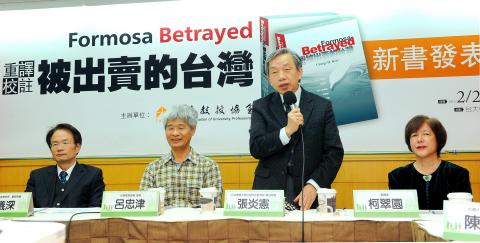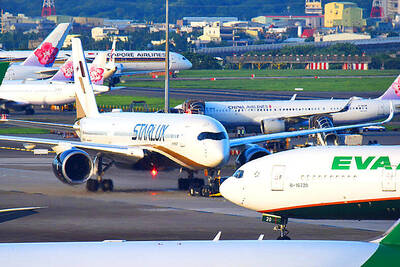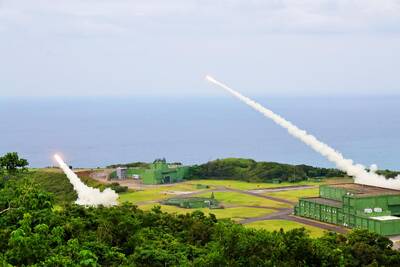Timed to coincide with 228 Memorial Day events this week, academics got together yesterday to launch a new Chinese-language translation of Formosa Betrayed — known locally as “被出賣的台灣” — an influential book on the nation’s post-World War II political transition written by US diplomat George Kerr in 1965.
Published by the Taiwan Association of University Professors (TAUP), the new edition is an update, with corrections and numerous references and explanatory notes added, of the 1974 Chinese-language translation of the book by Ronald Chen (陳榮成) and other young Taiwanese academics living in the US at the time.
“This book had a tremendous influence on Taiwan’s democracy movement. When overseas Taiwanese students read Kerr’s original book in English in the 1960s and 1970s, a lot of them were thoroughly shaken up. They turned around to embrace the Taiwan independence cause,” TAUP president Lu Chung-chin (呂忠津) said at the book launch yesterday.

Photo: Wang Min-wei, Taipei Times
Lu added that it was the overseas students’ first encounter with eyewitness reports on the tragic events of February and March 1947, and the book also prodded them to question the then-Chinese Nationalist Party (KMT) government’s version of events. They began to have misgivings on how much the KMT had distorted and falsified Taiwan’s wartime and post-war history.
Kerr was a teacher in Taiwan from 1937 to 1940. After the war he returned to Taiwan to serve as vice consul of the US diplomatic mission from 1945 to 1947, and later became a professor at universities in the US. He was an eyewitness to KMT forces’ atrocities in the spring of 1947, which Kerr unequivocally described as the “March Massacre” in his book.
Work on the new edition began in 2010. Chan Li-ju (詹麗茹) and Lanny Chen (柯翠園) were the translators.
Chen yesterday choked with emotion when she described translating Kerr’s original manuscript.
“It was a very painful process for me to go through the book word by word. Every so often, I could not control my tears and kept crying, and had to stop work. I was grief-stricken when I read about how my compatriots were tortured and killed [by KMT troops],” she said.
“I normally produce several thousand words a day when I do translations. However, this book was a difficult and emotional experience. It took me much longer to finish than other translations. I was only able to translate 11 chapters over five months,” Chen said.
Led by Taiwan Society president Chang Yen-hsien (張炎憲), five professors at TAUP were responsible for post-translation editing, research, fact-checking, and verification against historical documents and national archive files.
“Four decades after the first Chinese-language edition [of the book] came out, we have a rejuvenated script with restored interpretations of the contents of Formosa Betrayed. It is a very meaningful work,” Chang said.
“I believe the book should be a must-read for students learning about Taiwan’s history and the 228 Massacre in 1947,” he added.
“First, Kerr’s first-hand account is very important for historians and Taiwanese. He was there taking down his observations, becoming an important witness to history,” Chang said.
“Second, Formosa Betrayed and the translated editions are of great value for academics. It is a whole field of study by itself, for academic studies of Kerr’s lifetime body of works, with renewed interpretations of history from contemporary perspectives,” Chang added.
He said that Kerr’s 1965 original publication is hailed as a classic and had withstood the test of time.
“This updated translation can be seen as a representative history book for our time. We have made a comprehensive re-examination of the book, to clarify the meanings, made corrections [to the 1974 translation] and provided our best current interpretation of that chapter of Taiwan’s history,” Chang said.
Chen Yi-shen (陳儀深), a research fellow at Academia Sinica and a member of the editing team, gave an example of corrections to the text.
He said that where Kerr wrote about the government radio station in Taipei in February 1947, where after a certain incident “the station went off the air,” it was erroneously translated into Chinese as “the station exploded” in the 1974 edition. The translation has been rectified.

Trips for more than 100,000 international and domestic air travelers could be disrupted as China launches a military exercise around Taiwan today, Taiwan’s Civil Aviation Administration (CAA) said yesterday. The exercise could affect nearly 900 flights scheduled to enter the Taipei Flight Information Region (FIR) during the exercise window, it added. A notice issued by the Chinese Civil Aviation Administration showed there would be seven temporary zones around the Taiwan Strait which would be used for live-fire exercises, lasting from 8am to 6pm today. All aircraft are prohibited from entering during exercise, it says. Taipei FIR has 14 international air routes and

Taiwan lacks effective and cost-efficient armaments to intercept rockets, making the planned “T-Dome” interception system necessary, two experts said on Tuesday. The concerns were raised after China’s military fired two waves of rockets during live-fire drills around Taiwan on Tuesday, part of two-day exercises code-named “Justice Mission 2025.” The first wave involved 17 rockets launched at 9am from Pingtan in China’s Fujian Province, according to Lieutenant General Hsieh Jih-sheng (謝日升) of the Office of the Deputy Chief of the General Staff for Intelligence at the Ministry of National Defense. Those rockets landed 70 nautical miles (129.6km) northeast of Keelung without flying over Taiwan,

City buses in Taipei and New Taipei City, as well as the Taipei MRT, would on Saturday begin accepting QR code payments from five electronic payment providers, the Taipei Department of Transportation said yesterday. The new option would allow passengers to use the “transportation QR code” feature from EasyWallet, iPass Money, iCash Pay, Jkopay or PXPay Plus. Passengers should open their preferred electronic payment app, select the “transportation code” — not the regular payment code — unlock it, and scan the code at ticket readers or gates, General Planning Division Director-General Liu Kuo-chu (劉國著) said. People should move through the

The Ministry of National Defense (MND) today released images of the military tracking China’s People's Liberation Army (PLA) movements during the latest round of Chinese drills around Taiwan. The PLA began "Justice Mission 2025" drills today, carrying out live-fire drills, simulated strikes on land and maritime targets, and exercises to blockade the nation's main ports. The exercises are to continue tomorrow, with the PLA announcing sea and air space restrictions for five zones around Taiwan for 10 hours starting from 8:30am. The ministry today released images showing a Chinese J-16 fighter jet tracked by a F-16V Block 20 jet and the